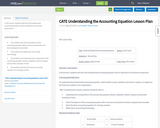
In this lesson, students will learn the fundamental accounting equation and its importance to business transactions.
- Subject:
- Business and Information Technology
- Career and Technical Education
- Education
- Material Type:
- Lesson
- Date Added:
- 08/30/2019

In this lesson, students will learn the fundamental accounting equation and its importance to business transactions.
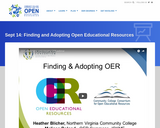
Faculty who are new to OER may experience difficulty finding an open textbook or other openly licensed materials to adopt for their courses. Searching on your own is time consuming and the choices can be overwhelming. We will hear from a college librarian who helps faculty find and adopt high quality OER to match their course outcomes and the creators of the award winning OER Commons, a freely accessible online library that allows teachers and others to search and discover open educational resources (OER) and other freely available instructional materials.
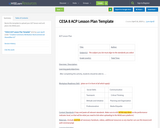
Remix this template to upload your ACP lesson and unit plans into WISELearn.
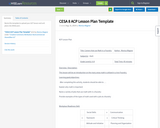
Remix this template to upload your ACP lesson and unit plans into WISELearn.

Through a multicultural lens, this textbook covers the development of young children, between 3-8 years.
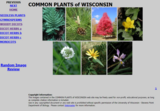
Common Plants of Wisconsin - developed by UW Stevens Point Department of Biology.
Pictures and descriptions of each common plant found in Wisconsin. Organization topics include: Seedless Plants, Gymnosperms, Woody Dicots, Dicot Herbs, and Monocots.
Copyright information:
The images contained in the COMMON PLANTS of WISCONSIN web site may be freely used for non-profit, educational purposes, as long as complete citation information is included.
Use in any copyrighted document or any web site is prohibited without specific permission of the University of Wisconsin - Stevens Point Department of Biology. Please contact Webmaster for more information.

The educator self-assessment can be used by districts to survey classroom teachers and specialists to see how computer science is currently being integrated into individual classrooms. The survey is organized by sections aligned to the Wisconsin CS standards, with individual response questions based on learning priorities within that standards. The results of this educator self-assessment could be used to see how and where CS standards are being taught, to address gaps in computer science instruction, and to identify areas in which educators need additional professional development.
The live Google Forms version can be found here: https://docs.google.com/forms/d/e/1FAIpQLSdkCcBwHv84UK1TXi0VgWngcE1JvCDAFuYq_ttSJ_d3sDVtug/viewform
Please contact CESA 11 if you would like an editable Google Form version.

The educator self-assessment can be used by districts to survey classroom teachers and specialists to see how computer science is currently being integrated into individual classrooms. The survey is organized by sections aligned to the Wisconsin CS standards, with individual response questions based on learning priorities within that standards. The results of this educator self-assessment could be used to see how and where CS standards are being taught, to address gaps in computer science instruction, and to identify areas in which educators need additional professional development.
The live Google Forms version can be found here: https://docs.google.com/forms/d/e/1FAIpQLScSo1-Q0y87e7dj7l-jGGLGeQUe-4dRmeItj9pDTPpEwcKU7A/viewform
Please contact CESA 11 if you would like an editable Google Form version.

The educator self-assessment can be used by districts to survey classroom teachers and specialists to see how computer science is currently being integrated into individual classrooms. The survey is organized by sections aligned to the Wisconsin CS standards, with individual response questions based on learning priorities within that standards. The results of this educator self-assessment could be used to see how and where CS standards are being taught, to address gaps in computer science instruction, and to identify areas in which educators need additional professional development.
The live Google Forms version can be found here: https://docs.google.com/forms/d/e/1FAIpQLSefXpaJkHLhTezTOLZrIEkFNiA5Hnn9JMXm7-1G1mjtXKqVvQ/viewform
Please contact CESA 11 if you would like an editable Google Form version.

The educator self-assessment can be used by districts to survey classroom teachers and specialists to see how computer science is currently being integrated into individual classrooms. The survey is organized by sections aligned to the Wisconsin CS standards, with individual response questions based on learning priorities within that standards. The results of this educator self-assessment could be used to see how and where CS standards are being taught, to address gaps in computer science instruction, and to identify areas in which educators need additional professional development.
The live Google Forms version can be found here: https://docs.google.com/forms/d/e/1FAIpQLSdrMI_EBnml293_X54QAXzWsS5UKbE9TAYdxx3ZXPO9YAH_zQ/viewform
Please contact CESA 11 if you would like an editable Google Form version.
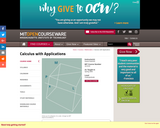
Differential calculus in one and several dimensions. Java applets and spreadsheet assignments. Vector algebra in 3D, vector- valued functions, gradient, divergence and curl, Taylor series, numerical methods and applications. Given in the first half of the first term. However, those wishing credit for 18.013A only, must attend the entire semester. Prerequisites: a year of high school calculus or the equivalent, with a score of 4 or 5 on the AB, or the AB portion of the BC, Calculus test, or an equivalent score on a standard international exam, or a passing grade on the first half of the 18.01 Advanced Standing exam.

This resource provides planning templates for teams to develop and calendar an annual plan for data access
and use throughout the school year. By setting a calendar for data use, leaders can insure that teams at every
level are provided the time and access to data needed for ongoing decision-making.
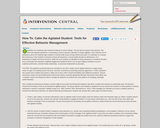
Students can sometimes have emotional outbursts in school settings. This fact will not surprise many teachers, who have had repeated experience in responding to serious classroom episodes of student agitation. Such outbursts can be attributed in part to the relatively high incidence of mental health issues among children and youth. It is estimated, for example, that at least one in five students in American schools will experience a mental health disorder by adolescence (U.S. Department of Health and Human Services, 1999). But even students not identified as having behavioral or emotional disorders may occasionally have episodes of agitation triggered by situational factors such as peer bullying, frustration over poor academic performance, stressful family relationships, or perceived mistreatment by educators.
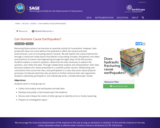
This resource is for teachers who want to teach their students about earthquakes and human involvement. This lesson plan is designed for older students to learn about earthquakes, hydraulic fracturing, and hydrocarbons while collecting and analyzing data to create a scientific poster of their findings based on their argument driven inquiry.
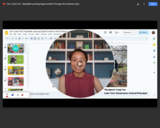
Introduction speech by Nkaujnou Vang-Vue, Principal at Lake View Elementary School in the Madison Metropolitan School District.
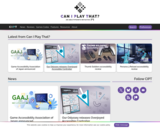
From their About Page: "Since our inception in November 2018 (Founded by Susan Banks and Courtney Craven), Can I Play that? (CIPT) has grown from a hobby site to a destination for players and developers alike that provides all forms of accessibility information on video games and the industry. Reviews, news stories, and features at CIPT exclusively report on the ever-growing presence and adoption of accessibility features within the gaming industry. Our work has been read and shared internally at studios around the world, such as Xbox, PlayStation, Ubisoft, Square Enix, and countless others, with support from Xbox and PlayStation executives, Phil Spencer and Hermen Hulst.
Can I Play That? works to share stories that influence game updates, inform disabled players, educate and entertain players and developers, and provide a voice for one of the largest player bases in the industry.
We have also developed professional workshops that tackle topics such as diversity, equity, and inclusion, and accessible community management. These workshops are available for studios to book, and we have already worked with Xbox, Ubisoft, Splash Damage, Square Enix, Creative Assembly, and more are to come as we expand our offerings"
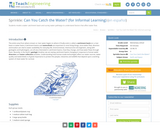
Students model a water catchment basin and survey water pathways to understand factors that affect water flow.

In this nonfiction story, young readers and listeners learn how scientists use cross sections from trees to reconstruct past climates. Versions are provided for readers at two levels, k-2 and 3-5, and in text-only and illustrated formats. The story is also available as an electronic book with recorded narration. An original story is a regular feature of each issue of the free, online magazine Beyond Weather and the Water Cycle. The story can be used in science and literacy lessons and activities throughout the magazine.
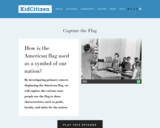
By investigating primary sources displaying the American flag, we will explore the various ways people use the flag to show characteristics such as pride, loyalty, and unity for the nation.
In this episode, students will engage in careful observation to identify flags and note details of the variety of places in which American flags are used (See).
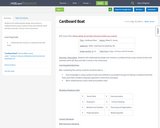
Students will collaboratively design and construct a cardboard boat using a variety of tools and methods which will float and hold 1 human in the school pool.